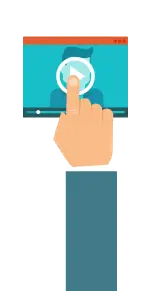Why should you caption and translate into Dutch?
The publication of videos on the Internet has increased a lot and is a type of content that is highly valued by users. Captioning and subtitling promotional and educational videos, in Dutch or in English, will make them available to a wider audience and at the same time will improve your SEO strategy. Our English <> Dutch translators will ensure that captions and subtitles are flawless and convey the meaning in the best way possible.
Now more than ever, companies and corporations are publishing all sort of video content: educational videos, promotional videos, guidelines for international employees or the latest speech of their CEO at a conference. Our native translators of Dutch and English will convey the right tone in the subtitles and captions and will condensed the message intended in the original audio.
We will edit and deliver the video ready for publication, following your brand fonts and even with your logo. Subtitles and captions are either burned onto the screen or sent as .srt, .sub or .slt file format. In order to give you a quote, just send us the original video and we will take care of the rest.
Captioning is the first step before translating
If you produced a video in English that you want to translate into Dutch, first you should get the captions and then translate into Dutch and into as many languages as you wish. Captions are specially useful for people with hearing disabilities, and also in noisy places (like airports and train stations) or in places where audio can be a nuisance, like hospitals. Captions are a transcription of the original audio. Some words might be changed and repetitions are deleted to get short and compact sentences.
Translation of subtitles from Dutch into English, or vice-versa
Once you are satisfied with the captions in the original language you can start translating into English or Dutch. Captioning and subtitle translation is offered between any language combination (Spanish-English-Dutch or any additional language).
Improve interaction with your videos
Adding subtitles to your videos in Dutch or in several languages, will greatly increase the time spend by your users watching your videos. And on top of that you will be reaching an audience located in places like Belgium, The Netherlands…
Our native English-Dutch linguists will accurately translate and convey into Dutch the message intended in your videos, and shape it into a targeted and understandable message that will convince your potential Dutch-speaking leads.
On a subtitled video, the user listens to the audio in the original language (Dutch or English, in our case) and is able to read the translations embedded at the bottom of the screen. Customers can then appreciate the narrator’s intonation and expressiveness. This is the way to get the message across with every nuance.
A cost-effective way to make your content profitable
The main advantage of subtitling over dubbing into Dutch is the cost, since there is no need to hire a recording studio or native speakears of Dutch. Our top-notch subtitling and captioning services in English and Dutch are an awesome way to boost your videos on YouTube or Vimeo. Subtitles are usually two lines long and appear on screen in sync with the audio.
Our translation and transcription services for English and Dutch are specially design to your specific needs. Translated subtitles should not be too long and adapt to the reading speed of an average user. For this type of translation we use a state-of-the-art software that allows to style fonts and control how captions are shown on screen.
Sample of a subtitled video
Did you know that...?
Of the almost 24 million Dutch-speaking (nederlands in Dutch) people in the Netherlands, Belgium (Flemish) and South Africa (Afrikaans), almost 90% have access to the Internet.
More language services in Dutch:
Captioning and subtitling in the following languages
Can we help?
Get a quote for captions in Dutch
Some facts about the Dutch language
Dutch originates from the Franconian dialect of Low German. In the 12th century it became the literary language of Middle Dutch.
From the seventeenth century the new Dutch became a fully independent language, and in South Africa it evolved into a dialect language called Afrikaans (also known as "Cape Dutch").
Dutch is a West Germanic language with about 28 million speakers, mainly in the Netherlands and Belgium. There are small Dutch-speaking communities in northern France around Dunkirk. Dutch is also spoken in Aruba, the Netherlands Antilles, Suriname and Indonesia.
The official or standard form of Dutch is known as Algemeen Beschaafd Nederlands (ABN), 'General Civilised Dutch'. It is taught in schools and used by the authorities in the Netherlands, Flanders (Belgium), Suriname and the Netherlands Antilles. An association known as Taalunie (Union of Languages), which was established by the governments of the Netherlands and Flanders, regulates the spelling and orthography of NBA. The alternative names for the ABN are Algemeen Nederlands (AN) and Standaardnederlands, Standard Dutch.
Dutch dialects spoken in Belgium are known as Flemish (Vlaams). They differ somewhat from the Dutch spoken in the Netherlands in intonation and pronunciation, and there are small differences in vocabulary, including words borrowed from French and English that are not found in standard Dutch.
The Dutch language evolved from the Lower Franconian dialect (Niederfränkisch) of Low German. The first known example of a document written in Old Franconian appears in a 9th century Latin manuscript, the Laws of the Salic Franks, and in translations of the Psalms. Some poetry written in Middle Dutch survives, dating back to the 12th and 13th centuries. The Dutch translation of the Bible, the Staten-Bijbel, from 1619-1637, was one of the first important works of modern Dutch.
